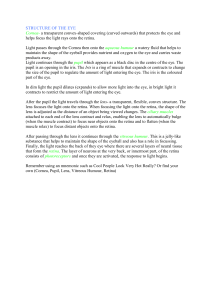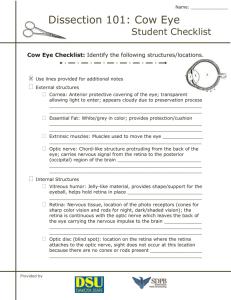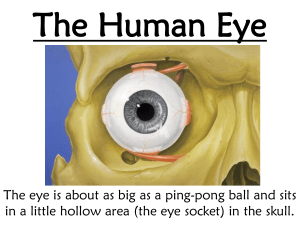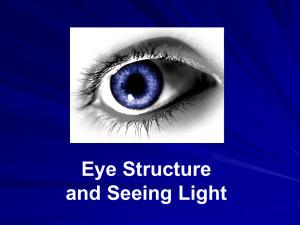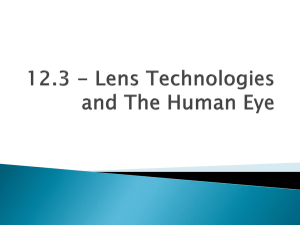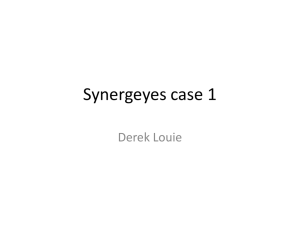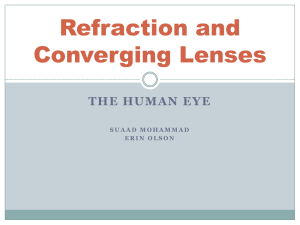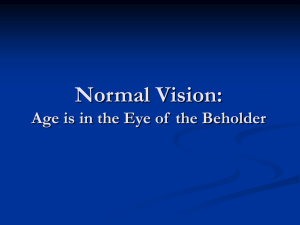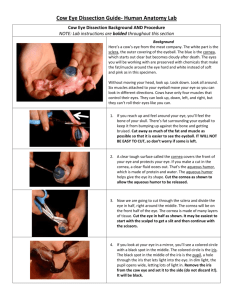8. The Senses and Nervous System
advertisement
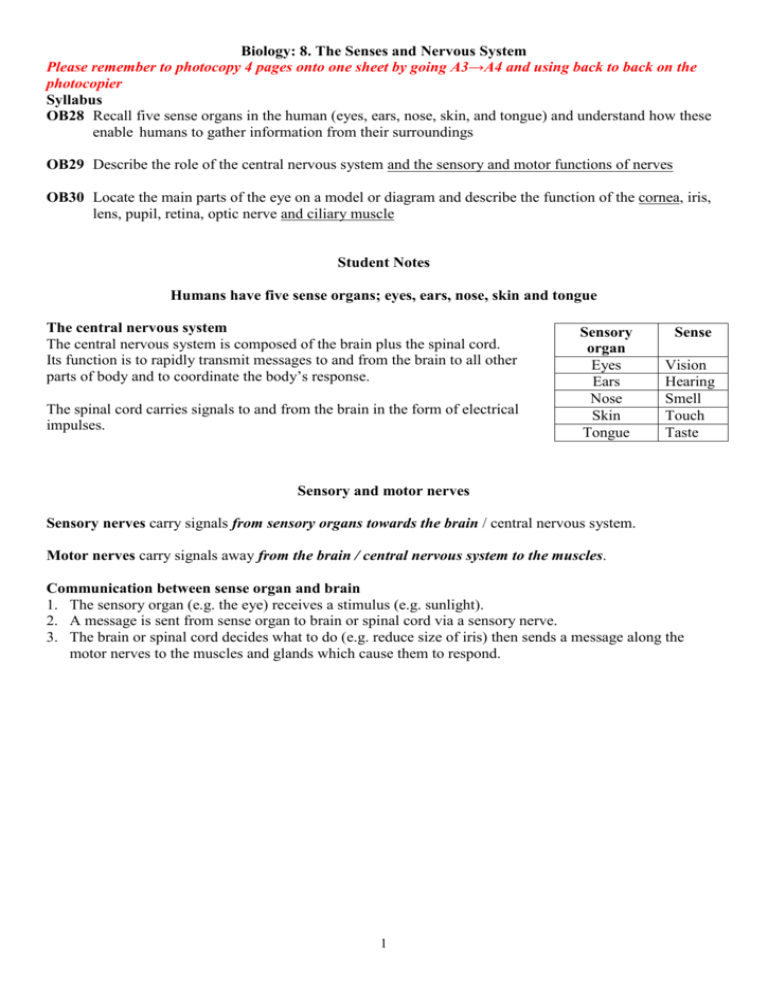
Biology: 8. The Senses and Nervous System Please remember to photocopy 4 pages onto one sheet by going A3→A4 and using back to back on the photocopier Syllabus OB28 Recall five sense organs in the human (eyes, ears, nose, skin, and tongue) and understand how these enable humans to gather information from their surroundings OB29 Describe the role of the central nervous system and the sensory and motor functions of nerves OB30 Locate the main parts of the eye on a model or diagram and describe the function of the cornea, iris, lens, pupil, retina, optic nerve and ciliary muscle Student Notes Humans have five sense organs; eyes, ears, nose, skin and tongue The central nervous system The central nervous system is composed of the brain plus the spinal cord. Its function is to rapidly transmit messages to and from the brain to all other parts of body and to coordinate the body’s response. The spinal cord carries signals to and from the brain in the form of electrical impulses. Sensory organ Eyes Ears Nose Skin Tongue Sense Vision Hearing Smell Touch Taste Sensory and motor nerves Sensory nerves carry signals from sensory organs towards the brain / central nervous system. Motor nerves carry signals away from the brain / central nervous system to the muscles. Communication between sense organ and brain 1. The sensory organ (e.g. the eye) receives a stimulus (e.g. sunlight). 2. A message is sent from sense organ to brain or spinal cord via a sensory nerve. 3. The brain or spinal cord decides what to do (e.g. reduce size of iris) then sends a message along the motor nerves to the muscles and glands which cause them to respond. 1 The Eye Be able to identify each of the following on a diagram and also know how to state their functions Part Function Cornea Allows light to pass into the eye Iris Controls the amount of light that enters the eye (it acts like a shutter) Lens Focuses light on the retina Pupil Opening through which light enters the back of the eye Retina Absorbs light and produces nerve impulses Optic nerve Carries messages from the eye to the brain Ciliary muscle Changes the shape of the lens when we look at near or far objects Test yourself – can you identify each of the following parts of the eye? 2 Exam Questions 1. [2007] Nerves carry electrical messages around our bodies. Nerves have motor functions and sensory functions. Explain the underlined terms. 2. [2007 OL] Complete the following sentence. The _________________ detects light. 3. [2007] The diagram is of the human eye. Name the part labelled A. 4. [2011 OL] The diagram shows the human eye. (i) Name the part labelled A. (ii) At which of the points A, B or C does the image form? 5. [2011][2007] What function has the ciliary muscle? 6. [2011] What is the function of the cornea? 7. [2008 OL] Examine the diagram and answer the questions that (i) Identify the part labelled A. (ii) Identify the part labelled B. (iii)What is the function of the part labelled A? 8. [2008] Give the function of the iris. 9. [2008][2008 OL] Give the function of the pupil. 10. [2008] The pupil is transparent. Why does the pupil appear to be black in most situations? 11. [2009 OL] What is the name of an organ which detects light? What is the name of an organ which detects sound? 3 follow. Exam Solutions 1. Motor function: to carry messages from the brain/ spinal cord/ central nervous system to muscles. Sensory function: to carry messages to the brain/ spinal cord/ central nervous system from sensory organs. 2. Eye 3. The lens 4. (i) A: lens (ii) B 5. It controls/ changes the shape of the lens. 6. Cornea: allows light into the eye/ transparent/ refracts light/ focuses light/ protection 7. (i) Retina (ii) Lens (iii)Allows light in 8. The iris controls the amount of light entering the eye 9. The pupil allows light to enter the eye 10. Light absorbed/ no light reflected out 11. Light: eye, Sound: ear Other Test Questions 1. Name the five sense organs and state what stimulus each sense organ responds to (e.g. “the eye responds to sight”). 2. The central nervous system consists of the __________________ and the ________________. 3. What is the function of the central nervous system? 4. Draw a diagram of the eye and include each of the following: the cornea, iris, lens, pupil, retina, optic nerve and ciliary muscle. 5. Give the function of each of the parts named above using the table below: Eye part The cornea The iris The lens The pupil The retina The optic nerve The ciliary muscle Function 4 Did you know? Butterflies don’t’ have ears but ‘hear’ sounds through their wings, by sensing changes in sound vibrations. The boy who sees with no eyes – see YouTube clip See TED.com clip about insect hooked up to computer. Did you know? Some cardiac patients now have their very own IP address. If their heart rate gets too high then the defibrillator can communicate wirelessly to their phone where it can in turn get transmitted via Wi-Fi or 3G to their doctor who can take emergency action if need be. Why does the sound of your voice seem different when you hear it recorded and played back? Did you know there exists a rare condition which, if you have it, means that you don’t feel any pain? Why is this a bad thing? 5


